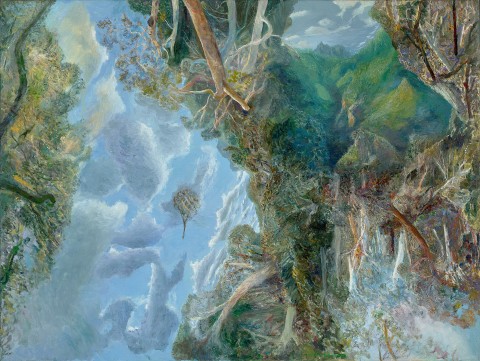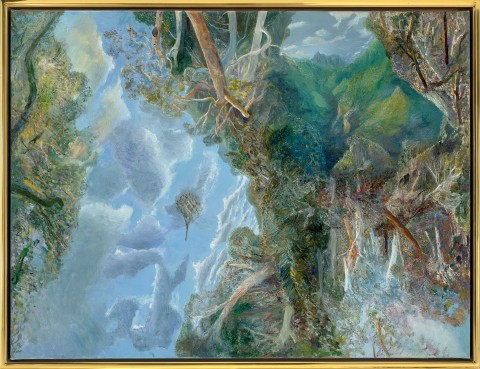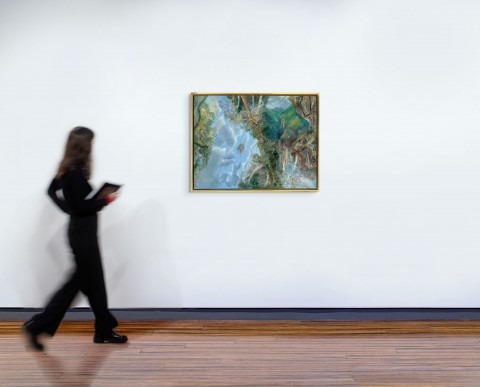CREATION LANDSCAPE – THE ANCIENT TREES, 1998
WILLIAM ROBINSON
oil on linen
76.5 x 101.5 cm
signed and dated lower right: William Robinson 98
bears inscription verso: C. L. Ancient Trees study - right
bears inscription on backing verso: Creation Landscape – the Ancient Trees 1997 [sic]
Collection of the artist, Brisbane
Philip Bacon Galleries, Brisbane
Private collection, Queensland, acquired from the above 18 April 2007
Creation landscape – the ancient trees, 1997, oil on canvas, 200.0 x 819.5 cm (overall), private collection, illus. in Darkness & Light: The Art of William Robinson, Queensland Art Gallery, Brisbane, 2001, pl. 72, pp. 128 – 129
While many Australian landscape painters traditionally looked towards Australia’s arid interior for inspiration, William Robinson embraced the rich rainforests and towering high country of Queensland mountain ranges for his most profound and important compositions. His unique contribution to the Australian landscape painting tradition involves a radical upending of conventional perspective to encompass the contrasting environments of rainforest and ocean; ground and sky; day and night; the elemental forces of wind, lightning, rain and fire.
The dramatic features of the granite belt, with its soaring cliffs, meandering rivers, creeks and plummeting waterfalls offer Robinson the material he requires to flex his masterly innovations. Each new series is built upon the achievements of the previous, as he pushes the boundaries of his artistic abilities and the conventions of landscape painting.
Amongst Robinson’s most powerful works is the earlier, vast triptych, Creation Landscape – the Ancient Trees, 1997 (private collection), inspired in part by a visit to the French High Gothic masterpiece, Chartres Cathedral. The central panel of the work features a stand of Antarctic Beech trees, believed to be two thousand years old, and it is easy to compare these ancient giants to the towering buttresses that support the roof of the Cathedral – similarly reaching toward the heavens. Significantly, the present work, Creation Landscape – the Ancient Trees, 1998, was painted after the third panel of the large triptych and was intended for the artist’s private collection. Indeed, the artist felt so strongly about the third panel of his celebrated triptych, that in 1998, following a further visit to Chartres Cathedral, he returned and painted the present composition as a homage. Perhaps he wanted a tangible reminder after the art critic for The Weekend Australian Giles Auty gushed that: ‘…when I first set eyes yesterday on William Robinson’s Creation Landscape – the Ancient Trees, I realised I was standing before a work of primary importance in the whole history of painting in Australia.’1 In his most ambitious work, Robinson gives equal weight to the physical grandeur of ancient forms, as he does to the ephemeral elements of light, mist, mood and atmosphere. But through the 1990s at time when his faith may have been tested, Robinson’s work took on a much deeper spiritual quality.
In the act of painting there is a tipping point where the work takes over and a seamless synergy occurs between the artist, their materials and subject. The artist becomes the vehicle for the work and almost takes a backseat as the painting evolves in inspired revelation. Artists sometimes refer to a work painting itself when describing this shaman -like relationship between the artist and subject. Robinson arrives at this point early and you can feel the urgency his works attain as they reach toward a higher state of observation and translation. This state of oneness with the work is achieved by continuous immersion in the act of creation and Robinson typically works every day, all day – except Sundays. The artist is a deeply religious man, and his paintings can be viewed as a personal homage to the Creator. God rested on the sabbath and so does Robinson, reserving this day for reflection and music in humble observance of the Maker’s achievements. Like the Renaissance masters Robinson so much admires who grasped immortality through magnificent architecture and art, he too looks to the heavens for his inspiration.
1. Auty, G., ‘Auty Declares: I spy with my learned eye an Australian masterpiece’, The Weekend Australian, 28 – 29 March 1998, p. 3
HENRY MULHOLLAND


